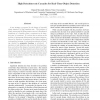Free Online Productivity Tools
i2Speak
i2Symbol
i2OCR
iTex2Img
iWeb2Print
iWeb2Shot
i2Type
iPdf2Split
iPdf2Merge
i2Bopomofo
i2Arabic
i2Style
i2Image
i2PDF
iLatex2Rtf
Sci2ools
ICCV
2007
IEEE
2007
IEEE
High Detection-rate Cascades for Real-Time Object Detection
A new strategy is proposed for the design of cascaded object detectors of high detection-rate. The problem of jointly minimizing the false-positive rate and classification complexity of a cascade, given a constraint on its detection rate, is considered. It is shown that it reduces to the problem of minimizing false-positive rate given detectionrate and is, therefore, an instance of the classic problem of cost-sensitive learning. A cost-sensitive extension of boosting, denoted by asymmetric boosting, is introduced. It maintains a high detection-rate across the boosting iterations, and allows the design of cascaded detectors of high overall detection-rate. Experimental evaluation shows that, when compared to previous cascade design algorithms, the cascades produced by asymmetric boosting achieve significantly higher detection-rates, at the cost of a marginal increase in computation.
Asymmetric Boosting Achieve | Computer Vision | Cost-sensitive Extension | Cost-sensitive Learning | False-positive Rate | ICCV 2007 | Rate Given Detectionrate |
| Added | 14 Oct 2009 |
| Updated | 14 Oct 2009 |
| Type | Conference |
| Year | 2007 |
| Where | ICCV |
| Authors | Hamed Masnadi-Shirazi, Nuno Vasconcelos |
Comments (0)

